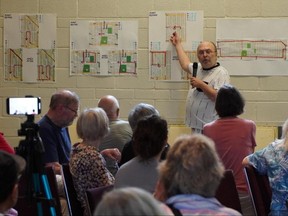“We were told it is a done deal. There’s nothing we can do about it.”

Can’t get their kids to school or their adult children with disabilities to therapy. Can’t get to a wedding or a funeral. Can’t park in front of their favourite bakery.
These are some of the complaints and worries some 130 residents of the Côte-des-Neiges—Notre-Dame-de-Grâce borough voiced over the controversial bike path on Terrebonne St.
The concerns and mounting frustration were aired during a public information meeting at St. Monica’s Church on Saturday organized by the Association de voisinage de la rue de Terrebonne. Residents highlighted several points, including public access to schools and churches on the street and how businesses are being affected.
The 2.3-kilometre path will make Terrebonne St. a bidirectional road for cyclists and unidirectional for vehicles, with one-way eastbound traffic between Cavendish Blvd. and Girouard Ave., and one-way westbound traffic between Cavendish and Belmore Ave. This project is meant to create safer routes for cyclists and pedestrians while integrating with existing cycling infrastructure in the borough. Work is expected to finish by July 15.

Accessibility
“We now have to travel all the way to Kensington, Sherbrooke and then along Sherbrooke on Cavendish and Monkland,” said Elizabeth Whiteman, a retired parent of a child with disabilities, about the new changes for traffic. Whiteman’s daughter, now an adult, uses a wheelchair.
Whiteman said the bike path’s current design significantly disrupts her ability to transport her daughter.
Whiteman also pointed out the winter challenges, noting that the city often fails to clear snow from wheelchair-accessible areas, making transport difficult.
“All winter, I was calling the city because they weren’t plowing the snow out where you have to get the transport. Yet they’re planning to shovel it all out for the bicycles in winter,” she said. “It’s frustrating.”
Whiteman also highlighted the limitations of public transport adaptation for her daughter, which has become less feasible as her daughter’s condition has worsened.
Previously, biking advocates and infrastructure experts highlighted the safety improvements that the new plan would bring for cyclists on Terrebonne as well as the importance of a holistic approach to urban planning.
Increased carbon dioxide emissions resulting from the extra travel was also a concern for Whiteman, a subject that N.D.G. resident Steve Jackson shared interest in. Jackson said he believed the new bike lanes were inefficient and displayed detailed posters outlining the resulting traffic changes and increased travel distances.

St. Monica’s
Paul Wong, a warden at St. Monica’s Church, spoke on its behalf about the adverse effect the path would have on elderly residents and the church community.
“For three or four people that come to the church on a bike … we don’t have access for the many others in vehicles — let alone for an event,” Wong said.
He expressed concerns over the lack of parking for funerals, weddings and even regular church services and asked how the community can maintain its activities if it can’t provide adequate parking.
Wong said efforts to propose alternative solutions to the borough were met with resistance.
“We were told it is a done deal. There’s nothing we can do about it,” he said.
Wong’s frustration was palpable as he described the borough’s refusal to accommodate local residents’ needs despite assurances from city officials like Robert Beaudry of the central executive council. Beaudry was not in attendance.

Businesses
Clare Keays, an N.D.G. resident and parishioner of St. Monica’s, said she’s worried about the ripple effect on local businesses. Keays said extended outdoor dining areas, put in place during the pandemic, continue to take up parking spaces.
“The detours are affecting just getting there,” she said.
The bike path complicates access to shops and services on surrounding streets even further, she said.
Keays shared her interactions with local merchants, including a bakery owner who was vocal against the bike path.
“She was just on fire … she just hated the idea,” Keays recalled.
“Converting streets to one-way streets is something a lot of cities have often done to ease traffic flow,” explained Moshe Lander, a senior lecturer in the department of economics at Concordia University.
He emphasized the potential benefits, such as reduced accidents and smoother traffic. However, he acknowledged the concerns of business owners about decreased visibility and accessibility, especially for corner stores and those at the beginning of the street.
“Businesses fear that these changes will hurt their visibility and, consequently, their revenue,” he said.
Lander acknowledged the longstanding discontent among business owners because of traffic changes. He noted the contention surrounding the reduction to one-way traffic on Cavendish and its effect on businesses, an ongoing concern for several years.
Lander also pointed out the challenges of balancing traffic flow and business interests, a common issue in urban planning.
“It’s a classic argument about how traffic flows when you move from two-way to one-way streets,” he added.

Opposition
Sonny Moroz, the Ensemble Montréal opposition councillor in Snowdon, attended the meeting, offering his perspective as both an N.D.G. resident and councillor.
The borough, which had no representation at Saturday’s meeting, has stayed firm in continuing bike lane construction. But the borough stated it will continue to work with institutions like St. Monica’s and the Mackay Centre and Phillip E. Layton school complex during its latest council meeting.